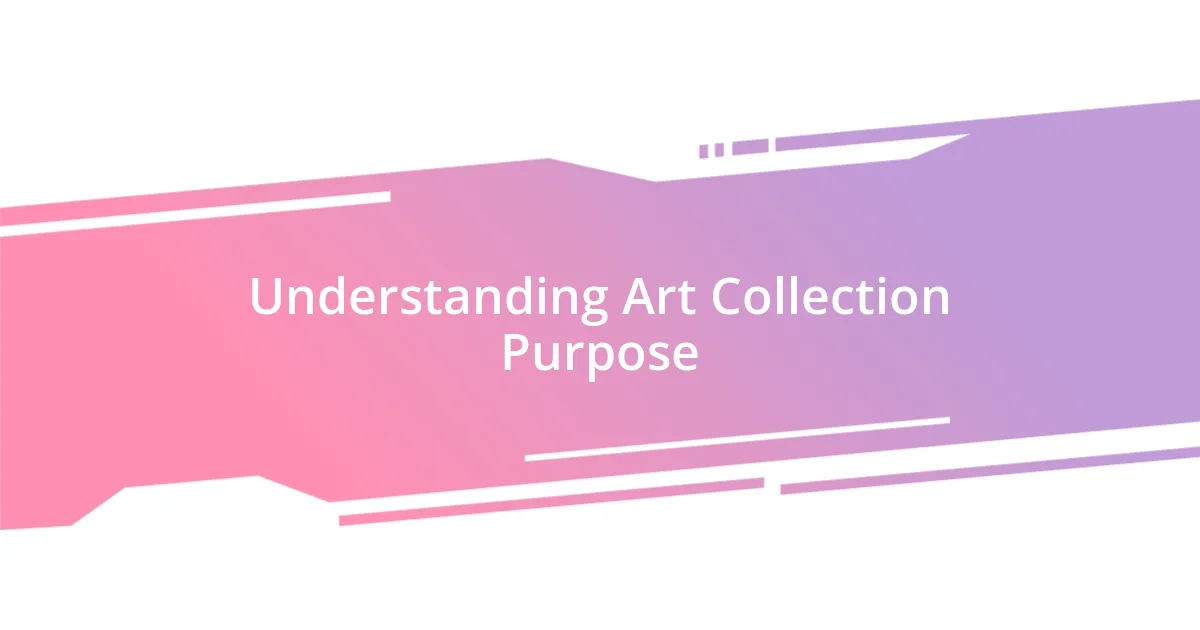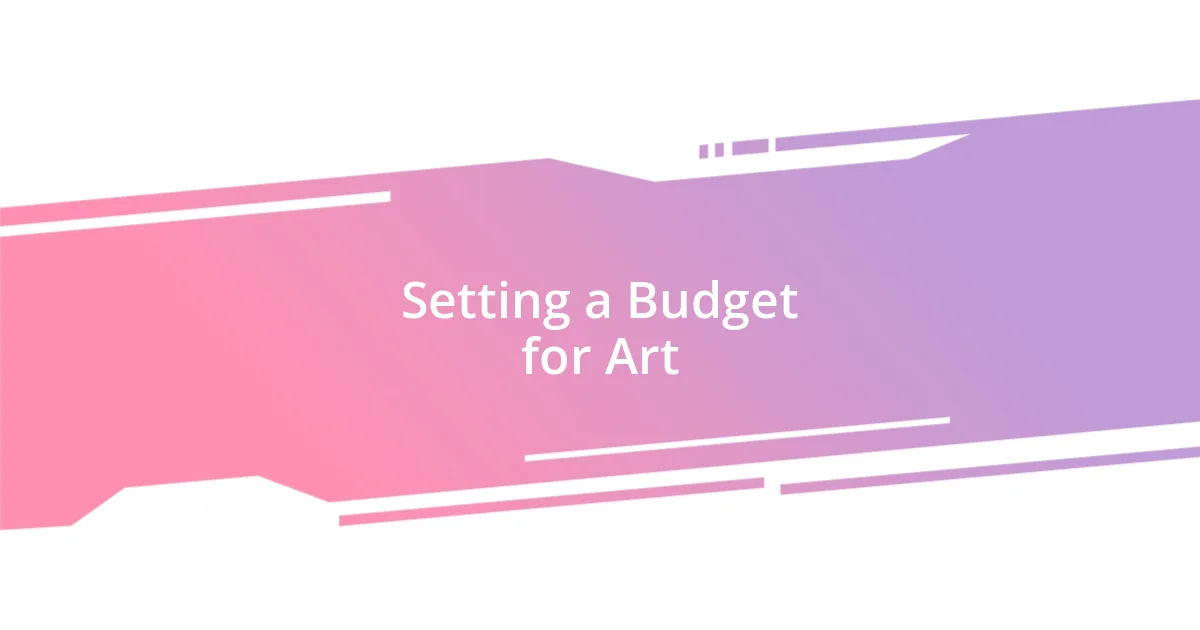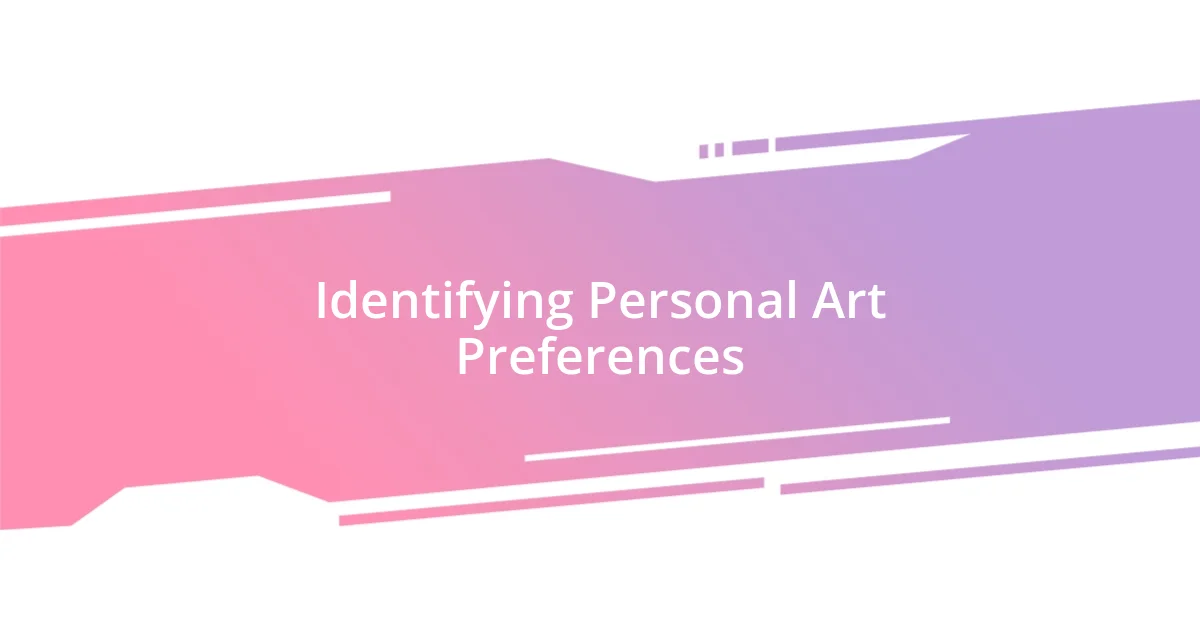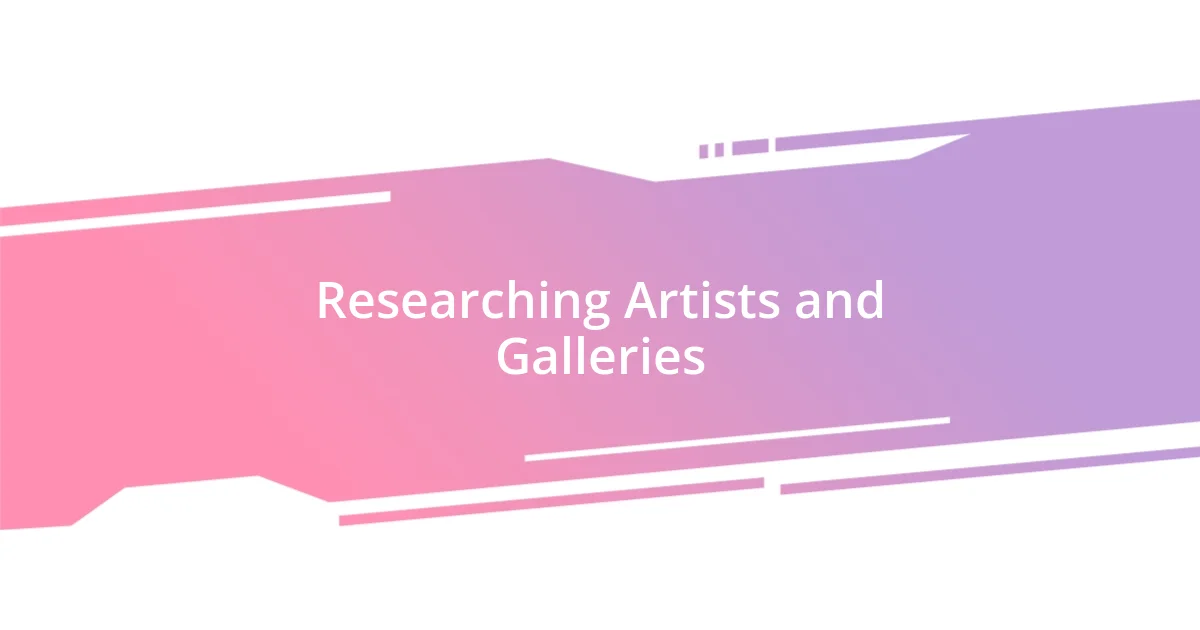Key takeaways:
- Art collection serves as a personal narrative, reflecting identity, memories, and emotional connections to various pieces.
- Establishing a clear budget and understanding personal preferences enhances the art curation process, allowing for thoughtful purchases and exploration of diverse artists.
- Caring for an art collection involves maintaining environmental conditions, routine upkeep, and documenting pieces to deepen appreciation and connection to the artwork.

Understanding Art Collection Purpose
When I think about the purpose of art collection, I often reflect on my own motivations. For me, each piece is not just an object; it’s a story, a moment captured in time that resonates with something deeper within me. Can you remember a time when a piece of art made you feel something profound? That’s the magic—art can evoke emotions that words sometimes fail to express.
Understanding the purpose behind collecting art also means recognizing its role in shaping our environments. I feel that art not only beautifies a space but also reflects our identity and values. Curating my collection has allowed me to curate my narrative, each artwork a chapter that tells the journey of who I am and what I cherish. Have you noticed how a single piece can transform your mood and the atmosphere of a room?
Moreover, I believe art collection serves as a way to connect with the broader art community and history. When I acquired a piece from a local artist, it wasn’t just about the artwork itself; it was about supporting creativity and culture in my area. It raises the question: how does your collection fit into the larger context of the art world? For me, it’s about being part of something bigger, a shared appreciation for creativity that transcends individual experiences.

Setting a Budget for Art
Setting a budget for art is an essential step in the curation process. I remember the first time I decided to invest in a piece; I felt both excitement and apprehension. It helped to create a framework for my spending, dictating the types of art I could pursue without overextending myself financially. By having a clear budget, I discovered that it not only guided my purchasing decisions but also led me to unexpected artists and styles that I may not have initially considered.
To effectively set your art budget, consider the following:
- Total Expenditure: Determine an overall spending limit that fits comfortably within your finances.
- Individual Pieces: Allocate funds for each piece based on its importance and the artist’s reputation.
- Additional Costs: Factor in framing, shipping, and installation expenses to avoid surprises later.
- Investment Value: Decide if you want to collect pieces with potential future value, which may require a bit more budget flexibility.
- Ongoing Purchases: Leave room in your budget for new opportunities as your tastes evolve or as the art market shifts.
Establishing these parameters made my collection journey more enjoyable rather than overwhelming. It fostered a sense of control and excitement as I explored the vibrant world of art, one thoughtful purchase at a time.

Identifying Personal Art Preferences
Identifying my personal art preferences was an enlightening journey. I still remember the first gallery I visited—each piece seemed to jump out at me, but certain colors and themes resonated far more than others. I asked myself: what speaks to me? For me, it’s often bold colors and abstract forms that ignite my imagination. Exploring these preferences has allowed me to shape a collection that truly feels like an extension of myself.
As I delved deeper, I found that my emotional connection to art was a key factor in determining my preferences. There are artworks I could just gaze at for hours, losing myself in their textures and hues. Nostalgia plays a big role; pieces that remind me of moments from my childhood or places I’ve traveled to evoke feelings of comfort and joy. Have you ever felt the draw of a piece that takes you back in time? It’s amazing how art can anchor our memories and emotions.
To help clarify my preferences, I created a comparison table, contrasting types of art that attracted me with those I found less appealing. This simple act made it easier to identify recurring themes and elements, guiding my future purchases. Establishing these distinct preferences made my curation process not just clearer, but also more fulfilling.
| Art Type | Emotional Response |
|---|---|
| Abstract | Excitement and Curiosity |
| Realism | Nostalgia and Reflection |
| Minimalism | Calm and Serenity |
| Pop Art | Playfulness and Humor |

Researching Artists and Galleries
Researching artists and galleries became one of the most thrilling parts of my curation journey. I remember spending countless evenings scrolling through online platforms and social media, discovering emerging artists whose work resonated with me. It’s incredible how a simple hashtag can lead you to breathtaking creations and new perspectives, don’t you think? Each click opened a door to a world filled with stories and talent, and I found myself eagerly bookmarking favorites for future reference.
Visiting galleries in person was another exhilarating experience. Stepping into a space filled with diverse artwork charged my creativity in ways I hadn’t expected. I vividly recall my first visit to a local gallery; the curator offered insights that sparked my curiosity, prompting me to ask questions. Those conversations not only deepened my appreciation but also helped me understand the narrative behind each piece, making my collection more meaningful. Have you ever felt that infectious passion from someone else’s enthusiasm?
Engaging with artists via interviews and Q&A sessions turned the research process into a personal dialogue. I began to understand the motivations and inspirations behind their work. By following a few artists closely, I realized that their journeys often paralleled my own, reflecting shared themes of discovery and emotion. As I absorbed these stories, they transformed my view of art from mere decoration into a profound reflection of the human experience. The connections I formed helped solidify my choices when it came time to invest in their pieces.

Visiting Exhibitions and Art Fairs
Attending exhibitions and art fairs became my playground for discovering new talents and expanding my horizons. I remember stepping into a bustling art fair for the first time; the energy was palpable. Every booth held a unique story, and as I wandered from one to the next, I couldn’t help but feel inspired by the creativity surrounding me. Isn’t it fascinating how each artist’s work can encapsulate their dreams and struggles in a single piece?
Often, I’d find myself lost in conversations with fellow attendees sharing their opinions on various artworks. One particular encounter stands out to me, where I discussed a provocative installation that sparked a passionate debate about art’s role in society. That dialogue enriched my understanding of the artist’s intent, making me reconsider the themes I wanted in my collection. Art fairs, for me, became not just about purchasing pieces but about engaging in a larger conversation about culture and expression.
In those crowded halls surrounded by vibrant colors and evocative forms, I discovered that the thrill of the hunt was as exhilarating as finding the perfect piece. I recall making a spontaneous decision to purchase a painting after just a ten-minute conversation with the artist; their passion was infectious, and I felt an immediate connection to their story. How often do we let moments of impulse lead to something truly special? For me, that painting has become a cherished reminder of that inspiring day, encapsulating both the art and the energy that filled the air.

Making Informed Purchase Decisions
When it came to making informed purchase decisions, I learned early on that my instincts needed to be supported by research. For instance, I vividly recall a moment when I nearly impulsively bought a striking sculpture that had caught my eye. However, I took a step back to read up on the artist and their past work. This pause helped me realize that the sculpture’s price tag reflected not just its visual appeal but the artist’s established reputation and the value of their evolving technique. Isn’t it fascinating how knowledge can elevate your appreciation of an artwork beyond surface beauty?
I also started to consider the authenticity of the pieces I was interested in. One memorable occasion was when I attended a private viewing for an artist whose work I adored. A fellow collector shared tips on spotting reproductions versus original pieces, including the importance of certificates of authenticity. This conversation reshaped my approach to buying art; it wasn’t just about liking the work; it was about ensuring I was making a sound investment. Didn’t you ever wonder how much the backstory of a piece matters when deciding to bring it home?
Budgeting became another crucial element of my decision-making process. I remember setting a specific amount aside for art purchases each month, which not only gave me a sense of control but also created anticipation for my next find. One time, I stuck to my budget and attended a local auction, where I came across a stunning painting that had been overlooked by many bidders. My patience paid off as I successfully acquired it for less than I had planned! That experience reinforced my belief that informed decisions—rooted in research, dialogue, and a strong understanding of my preferences—can lead to extraordinary treasures. How empowering is it to know that thoughtful choices can shape your collection into something uniquely personal?

Caring for Your Art Collection
Caring for my art collection has always been a multi-faceted endeavor. One of the key lessons I learned early on was the importance of proper environmental conditions. I remember the first time I noticed a slight fade on a beloved painting due to too much sunlight. It was a heart-sinking moment that reminded me to invest in UV-protective glass and to find a good spot in my home to display my pieces. Have you ever considered how your surroundings can directly affect the life of your artwork?
Routine maintenance is equally essential. I once found myself dusting off an intricate sculpture, only to realize how much residue had built up over the years. It was a simple act, but as I gently cleaned it, I felt a renewed appreciation for the artist’s craftsmanship. That moment reinforced my belief that taking the time to care for each piece is an act of love and respect for the creators behind the works. After all, wouldn’t we want our cherished items to shine and celebrate their stories?
Lastly, I’ve found that keeping an inventory of my collection has been invaluable. I started documenting each piece, complete with details like purchase dates, artist backgrounds, and even personal reflections. This practice has transformed how I view my collection; it is no longer just a display but a living, breathing narrative of my artistic journey. How rewarding is it to revisit those memories, realizing how much each artwork has come to mean over time? Embracing this level of engagement has deepened my connection to the art world and enriched my experience as a collector.














